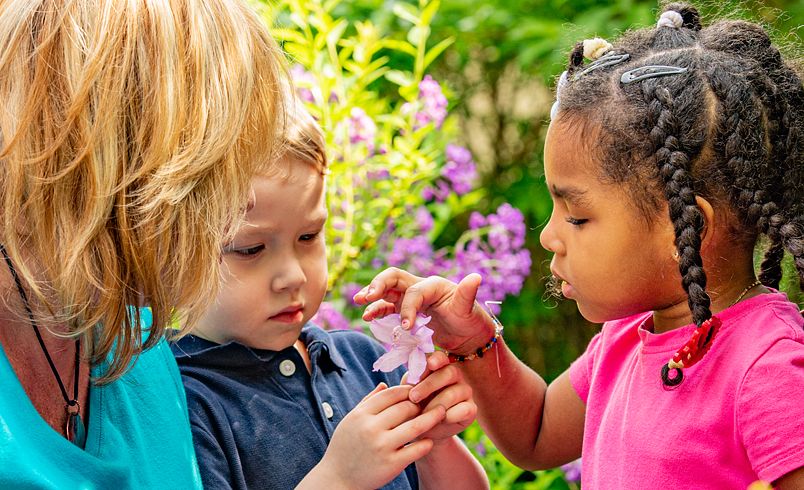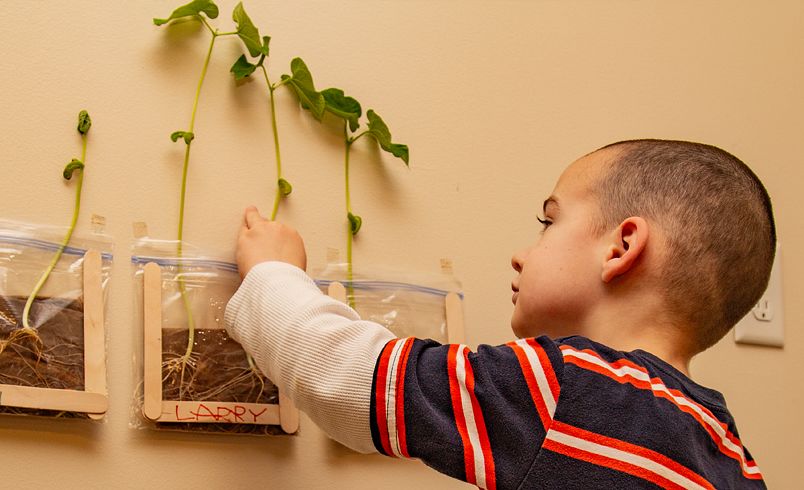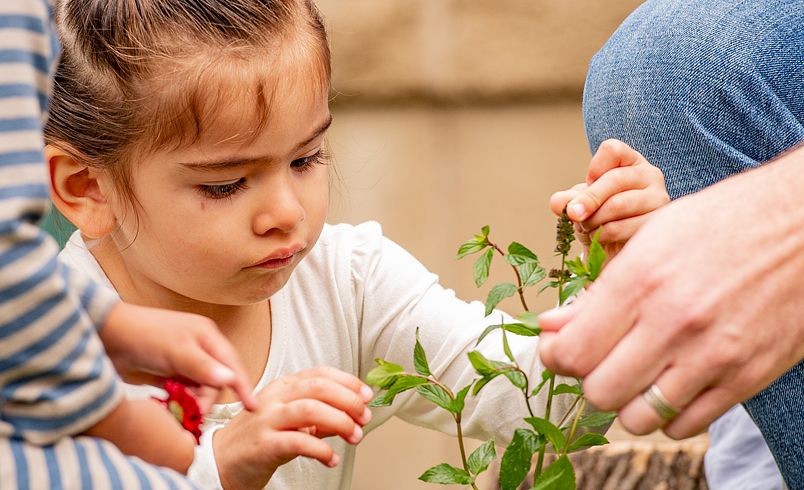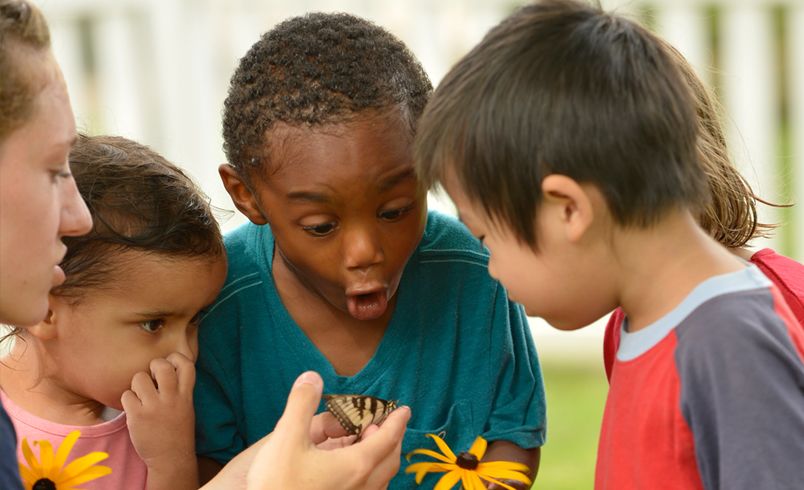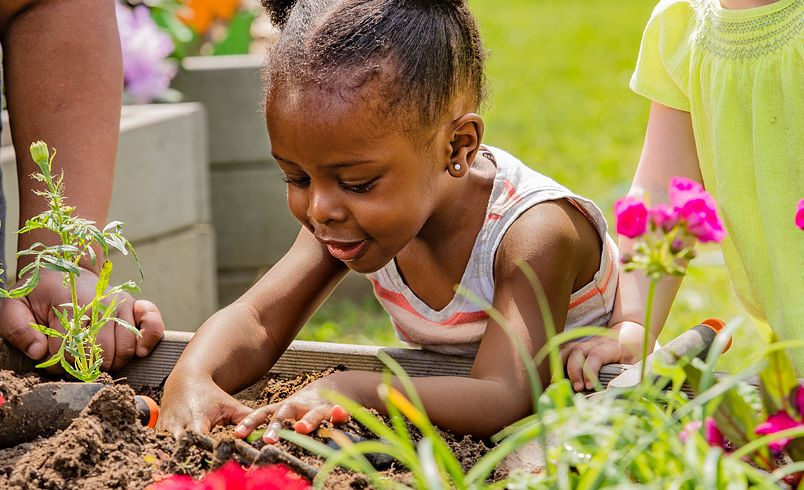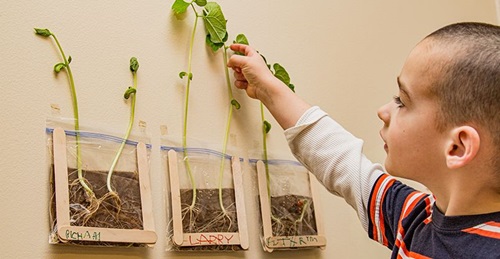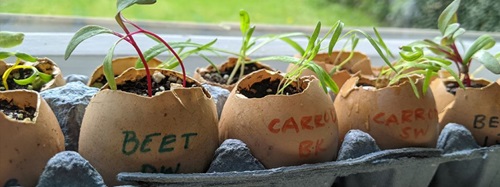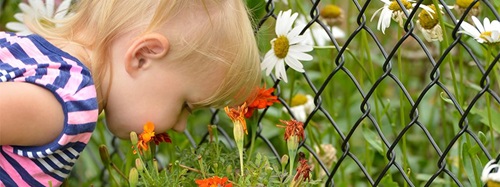Gardening with Young Children
| May 2020There is a garden in every childhood,
an enchanted place where colors are brighter,
the air is softer, and the morning
more fragrant than ever again.
Elizabeth Lawrence
Many adults have wonderful memories from childhood about growing things, planting a bean seed in a baggy to see it sprout, marigolds or sunflowers in a cup for Mother’s Day, or spending time with a cherished grandparent in their garden digging up carrots or eating fresh tomatoes off the vine.
Fewer children today have these memories. Busy lifestyles leave all of us with less time for pursuits such as these. How can you bring these experiences back into children’s lives? The simple answer is by adding gardening to your outdoor playground.
Gardening Guidelines
As the adult, you are not there to “teach” each child everything that is involved in gardening. Rather, your role is to act as a guide, engaging them in the delights of the natural world. Take time to recognize, notice, and orient the children to the wonders of growing things.
The first logical step in gardening is to grow something! Start with something small and simple. Plant only what you can easily maintain. Make sure the plants are varieties that are suited to your area. It’s hard to succeed unless you work with the climate where you are. If irrigation is an option on your playground (i.e., sprinkler systems or drip hoses) use it, so that you can continue to grow during dry spells and school breaks. Make a watering schedule, and get help when you can.
As your gardening efforts mature, it helps if you can plan an annual schedule for planting and maintenance. Scheduling the things that need to be accomplished can make sure that it all gets done.
Collecting Materials
Not everything costs money. Use community resources for acquiring seeds, plants, and environmental educational experiences for children and families. Free seeds are often available from arboretums, and tree give-aways are common around Arbor Day.
Found and Scrounged Materials
- Watering cans or alternatives such as coffee cans, milk jugs
- Containers to use as planters, including pickle buckets, flowerpots, or whimsical containers such as boots, shoes, pots, and pans
- Screens or small rocks to cover drain holes
- Compost, mulch, seeds, bulbs, starter plants
Purchased Materials
- Trowels, child-sized shovels
- Watering hoses, drip hoses, 2-way (or more) hose connectors, nozzles, wands, spray bottles
- Soil (purchase a good soil mixture from your local nursery)
- Seeds, bulbs, and starter plants
Planting and Gardening Activities
Gardening in Containers
One of the easiest ways to garden is to start a seed in a paper cup. Place a lima bean in a paper cup nearly filled with potting soil. Place on a sunny windowsill or secure outdoor spot. Continue watering lightly for a week, let the soil nearly dry out, then water again, rotating between moist and dry soil. As the plant grows, you can transplant it to a large container or outdoors in prepared soil.
Many containers can serve as garden pots. Everything from plastic milk cartons to five gallon buckets could become a mini-garden. Container gardening is a great way to begin if you aren’t sure you are ready to tackle gardening on a larger scale. You can grow herbs, lettuce, or green beans to add to your menu for snack or lunch.
Gardening on Trellises and Fences
Growing vegetables upright not only saves space, it also makes harvesting easier. Many plants readily climb when given structural support. An already existing playground fence makes a perfect trellis. If you don’t have a fence that will work, add a trellis next to a building. To provide support while the plants grow, you will need to use soft twine or twist ties to secure the branches to the support. Here are some vegetables that will do well on a vertical support:
- Tomatoes
- Green peas
- Green beans
- Cucumbers
- Squashes
Flowering plants love growing on fences and trellises as well. Here is a short list to consider:
- Coral Honeysuckle (Lonicera semperviren): Blooms throughout the year and attracts hummingbirds. It likes morning sun and afternoon shade.
- Passionflower Vine (Passiflora incarnate): The lavender flower blooms from early spring to the end of summer. It is the larval host plant for the Gulf Fritillary butterfly
- Clematis vine (clematis occidentalis) is a nice alternative to passionflower in northern climates.
Crossvine (Bignonia capreolata): Blooms in the spring in a striking red and yellow trumpet-shaped flower. Grows well in sun or shade.
Herb Garden Sensory Pathways
A herb garden provides an extraordinary sensory experience and gives the children an area in the garden that they can touch and explore freely. Plant some low-lying herbs such as trailing thyme or creeping marjoram, along the sidewalk to create a sensory pathway. Hardy rosemary plants can become a border along a pathway or entrance. Children can rub their hands along the shrubs to release the strong scent. Mint comes in many varieties. The velvety soft leaves of the lamb’s ear entice a child to touch it. The fennel plant smells like black licorice—a connection to jellybeans many children will quickly make. The fennel plant and dill both attract Black Swallowtail butterflies.
Wildscapes and Butterfly Gardens
Wildscapes are a wonderful addition to your outdoor space. In a wildscape, the focus is on plants and vegetation native to your area and the wildlife they invite. Hardy native plants can withstand the weather, rainfall, and soil conditions of your area and will grow with little intervention from you. They are also often perennials, coming back year after year, saving both time and money over the long term.
Wildscapes provide all the essential elements to support life—food, water, shelter, and space. Birds, butterflies, and other interesting visitors will be more likely to join you in the outdoors when your playground includes trees, shrubs, wildflowers, and grasses. You can make the space even more inviting by adding bird feeders, nesting boxes, rock piles, and bird baths to your wildscape ecosystem.
Two types of plants are needed in a butterfly garden: the larval food plant is for the caterpillars, and a nectar source is for the adult. There are approximately 700 species of butterflies in the United States. (Check the North American Butterfly Association. www.naba.org, for a list for your area.) As you have probably experienced, encounters with butterflies can be enchanting, rewarding, and educational for both you and the children in your program. When we installed host plants for butterflies at a Head Start program a few years ago, several butterflies showed up in less than an hour! We can’t guarantee such immediate results for you, but with some planning beforehand and careful selection of plants, butterflies and birds will indeed visit your garden for you and the children’s delight.
Tips for Developing a Wildscape
- Use native plants that can tolerate the climate specific to your area. Group plants according to their need for sun, shade, and water. A large mass of one kind of flower is more inviting to butterflies and birds.
- Select areas with natural edges, like sidewalks or fences, limiting edges that will require manicuring.
- Use groundcovers with natural extension into the landscape, but avoid grasses that will creep into unwanted area.
- Use mulch (wood chips, straw, leaves, needles) to reduce evaporation, keep soil moist, control weeds, and conserve water.
- Trim existing hedges into small trees. The children will use the areas underneath for cozy spaces and pathways. Plant new trees away from buildings to avoid fire danger.
- When possible, develop a wildscape management team that can share the responsibility of maintaining the wildscape. Divide duties based on the interests and skills of the participants.
Children’s natural curiosity will provide all sorts of learning experiences in the wildscape, as they observe natural life cycles over the course of the seasons and practice stewardship of the environment. Even if you only have a little space to plant wildflowers or a flowering vine, consider ways you can add hardy native plants to your playground. Gardening catalogues, local nurseries, and county extensions can help you decide which plants are best for your climate and available space.
Whatever garden you decide to create with children, know that you are offering them experiences that will stay with them life-long. In the words of Rachel Carson, the tireless advocate for the natural environment, from her book A Sense of Wonder:
If a child is to keep alive his inborn sense of wonder...he needs the companionship of at least one adult who can share it, rediscovering with him the joy, excitement and mystery of the world we live in.
Remember, with young children the goal is always to keep the outdoors and immersion in nature playful, so find the gardening activity that calls to you and enjoy!
This article was excerpted in part from the book Nature-based Play by Sharon Young, Kay Albrecht, and Halcyon Reese-Learned (2019). It may be purchased in ebook or epub format from the Innovations in Early Childhood Education website: innovationsinece.com.

